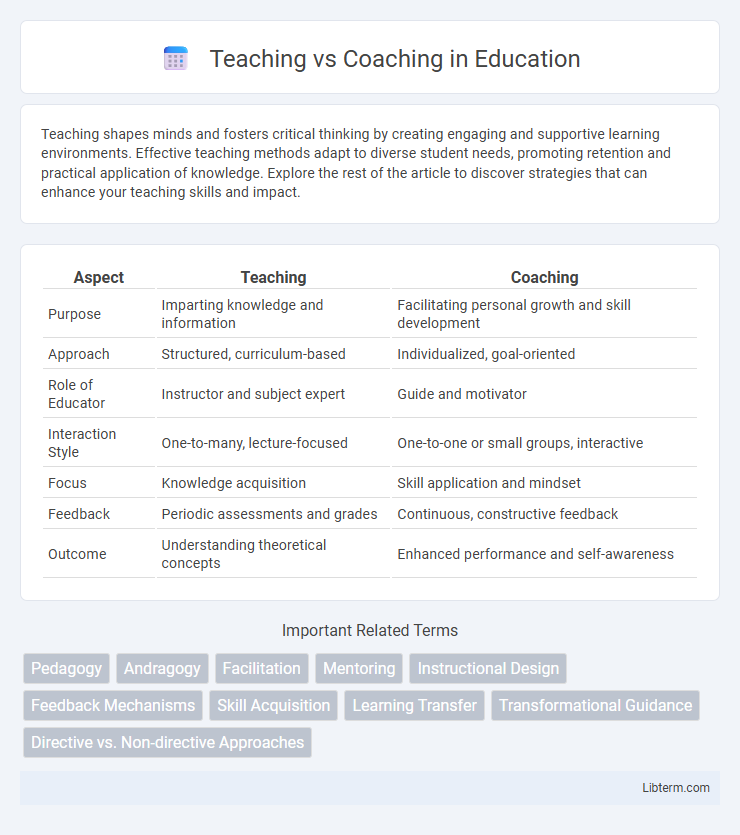Teaching shapes minds and fosters critical thinking by creating engaging and supportive learning environments. Effective teaching methods adapt to diverse student needs, promoting retention and practical application of knowledge. Explore the rest of the article to discover strategies that can enhance your teaching skills and impact.
Table of Comparison
| Aspect | Teaching | Coaching |
|---|---|---|
| Purpose | Imparting knowledge and information | Facilitating personal growth and skill development |
| Approach | Structured, curriculum-based | Individualized, goal-oriented |
| Role of Educator | Instructor and subject expert | Guide and motivator |
| Interaction Style | One-to-many, lecture-focused | One-to-one or small groups, interactive |
| Focus | Knowledge acquisition | Skill application and mindset |
| Feedback | Periodic assessments and grades | Continuous, constructive feedback |
| Outcome | Understanding theoretical concepts | Enhanced performance and self-awareness |
Understanding the Difference: Teaching vs Coaching
Teaching involves imparting knowledge and skills through structured lessons, focusing on content delivery and assessment of learning outcomes. Coaching centers on guiding individuals to unlock their potential by asking powerful questions, encouraging self-discovery, and developing personalized strategies. Recognizing the difference between teaching's directive approach and coaching's facilitative method enhances educational and professional development effectiveness.
Core Principles of Teaching
Teaching centers on structured knowledge delivery, emphasizing curriculum design, clear learning objectives, and assessment-driven progress. It prioritizes foundational skills, conceptual understanding, and cognitive development through direct instruction and feedback. Core principles include lesson planning, standardized evaluation, and fostering critical thinking within a guided learning environment.
Core Principles of Coaching
Core principles of coaching emphasize active listening, powerful questioning, and creating a supportive environment that empowers individuals to discover their own solutions. Unlike teaching, which often involves directive knowledge transfer, coaching focuses on facilitating self-awareness, goal-setting, and personal growth through reflective dialogue. This approach enhances motivation, accountability, and long-term skill development by fostering autonomy and intrinsic drive.
Roles and Responsibilities in Teaching
Teaching involves delivering structured knowledge through curriculum-based instruction, assessment design, and classroom management to facilitate student learning. Teachers are responsible for creating lesson plans, evaluating student progress, and providing feedback to ensure comprehension and skill development. They maintain discipline and foster an inclusive learning environment that supports diverse learner needs.
Roles and Responsibilities in Coaching
Coaching centers on facilitating personal and professional growth by guiding individuals to unlock their potential through active listening, powerful questioning, and goal-setting. Coaches foster a supportive environment that encourages self-discovery, accountability, and motivation, contrasting with teachers who primarily transfer knowledge and skills through structured instruction. Key responsibilities in coaching include establishing trust, customizing development plans, providing constructive feedback, and helping clients overcome obstacles to achieve sustained improvement.
Skills Required for Effective Teaching
Effective teaching demands strong communication skills, deep subject knowledge, and the ability to adapt instructional methods to diverse learning styles. Teachers must cultivate patience, empathy, and classroom management skills to create an engaging and supportive environment. Critical thinking and assessment skills are essential for evaluating student progress and tailoring feedback to foster growth.
Skills Required for Effective Coaching
Effective coaching requires strong communication skills, active listening, and empathy to understand coachees' unique needs and goals. Coaches must develop critical thinking and problem-solving abilities to facilitate growth and guide actionable steps. Emotional intelligence is essential for building trust and fostering a supportive environment that encourages self-reflection and motivation.
Situations Best Suited for Teaching
Teaching is best suited for structured learning environments where foundational knowledge and specific skills need to be delivered efficiently, such as classrooms and training sessions. It excels in scenarios requiring clear objectives, standardized content, and measurable outcomes, like academic instruction or technical training programs. This approach ensures consistent information transfer, essential for learners who need a solid understanding of core concepts before applying them.
Situations Best Suited for Coaching
Coaching is best suited for situations requiring personalized growth, performance improvement, and skill development through guided discovery and reflection. It excels in dynamic environments where feedback, adaptability, and self-directed learning foster sustained progress. Coaching supports leaders, athletes, and professionals aiming to unlock potential by addressing specific challenges and goals.
Choosing the Right Approach: Teaching or Coaching
Choosing the right approach between teaching and coaching depends on the learner's goals and context; teaching is ideal for delivering structured knowledge and foundational skills through direct instruction, while coaching excels in developing personalized growth, critical thinking, and problem-solving abilities by fostering self-discovery. In corporate settings, teaching suits onboarding and compliance training, whereas coaching drives leadership development and performance improvement by addressing individual challenges. Organizations benefit from combining both methods to maximize employee skill acquisition and adaptability in dynamic environments.
Teaching Infographic

 libterm.com
libterm.com